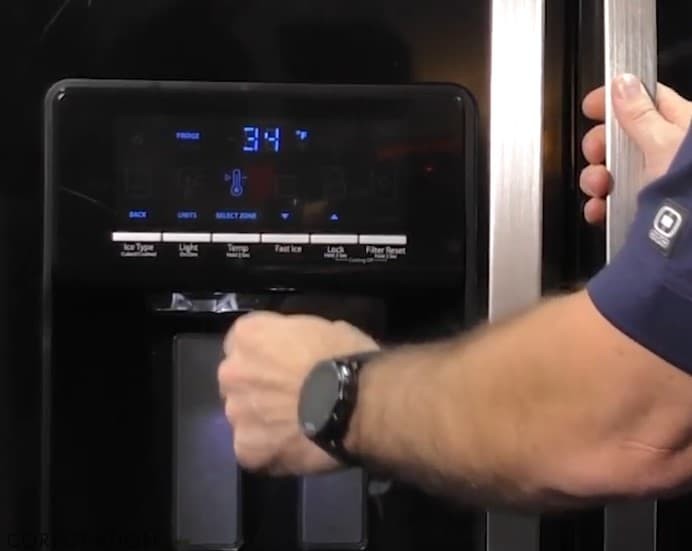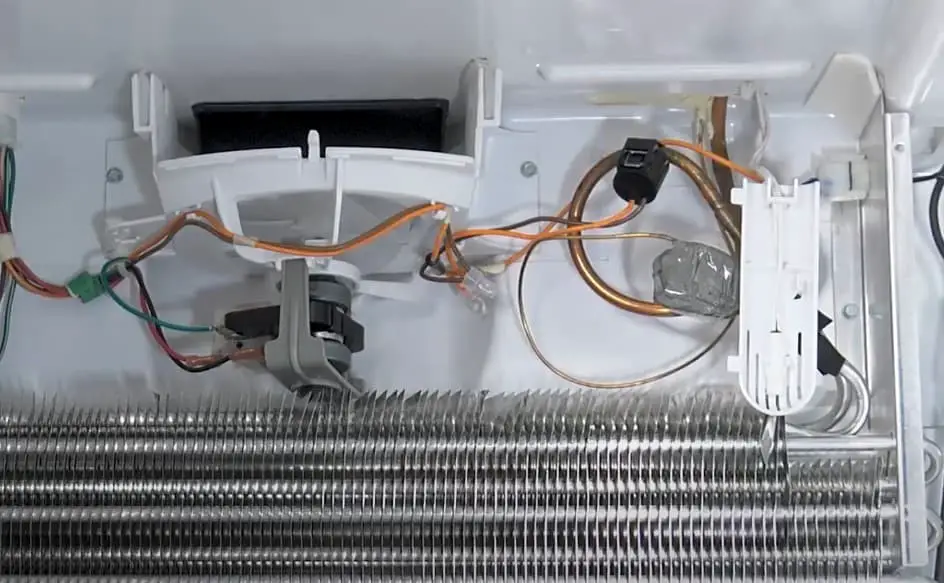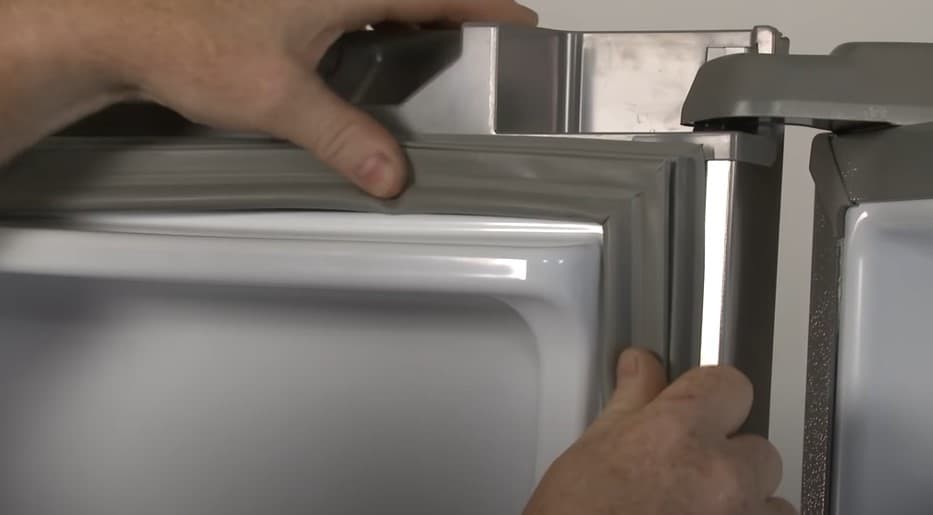10 Reasons For Whirlpool Refrigerator Not Cooling And {How To Fix}
Are you frustrated with your Whirlpool refrigerator’s lukewarm temperature or sour milk? It may be due to an inefficient cooling system. Before we dive into possible causes and fixes, let’s explore why refrigerators can malfunction. A warm refrigerator is not only inconvenient but also affects the entire appliance. Imagine spoiled food and wasted money – it’s a worrying situation. If your Whirlpool refrigerator freezer is chilly while the refrigerator itself is warm, don’t panic.
Simple DIY solutions can often resolve the issue. But what are the possible causes of this problem? Firstly, dirty condenser coils might be preventing proper cooling. Secondly, an overflowing refrigerator can disrupt temperature control. Thirdly, incorrect temperature settings or a misaligned refrigerator could be the culprit. Additionally, broken condenser fan motors, thermistors, thermostats, start relays, faulty door seals, or a malfunctioning compressor can also cause issues.
In this article, we’ll explore ten common causes of Whirlpool refrigerators not cooling properly and provide step-by-step solutions to fix each problem. From troubleshooting tips to DIY fixes, we’ve got you covered.
What Causes a Whirlpool refrigerator to stop cooling? And how to fix
When a Whirlpool refrigerator fails to keep your food chilled, it’s not just an inconvenience – it can also result in wasted money and spoiled groceries. Understanding what causes this issue is crucial to resolving the problem. In this context, we’ll explore the possible reasons behind a non-cooling Whirlpool refrigerator and provide guidance on how to troubleshoot and potentially fix the issue yourself, or when to seek professional assistance.
Condenser Coils that are filthy

Whirlpool refrigerators often experience cooling issues due to the condenser coils being clogged with debris, which prevents the efficient dissipation of heat. As a result, the refrigerator may produce unusual noises as it struggles to maintain a consistent temperature.
To resolve this issue, start by removing your Whirlpool refrigerator from its current location and accessing the rear and bottom sections.
The snake-like condenser coils might be partially concealed beneath the appliance, and you may also need to remove the toe guard at the front of the fridge for unobstructed cleaning.
Next, use a narrow hose attachment on your vacuum cleaner to thoroughly clean all external components, including the coils themselves. For any stubborn residue, employ specialized cleaning equipment – such as brushes available from Amazon or local hardware/grocery stores – to scrub away dirt and grime.
Finally, conduct a second round of vacuuming to remove any remaining debris.
Overflowing Refrigerator

When your fridge isn’t keeping its contents chilly but the freezer is doing just fine, it’s likely a sign that it’s overworked due to being overstuffed. When you cram too many items into your refrigerator, cold air can’t circulate effectively and products inside will eventually suffer. Without sufficient airflow, the fridge won’t be able to maintain a cool interior.
To prevent this and promote better air circulation within your refrigerator, follow these steps:
Firstly, get rid of any old or spoiled food containers and items that have gone bad. This will help declutter the space and make way for fresh products.
Next, give the inside of the fridge a good clean using warm soapy water and a lint-free cloth. This will not only remove any stubborn stains but also eliminate any lingering odors.
Finally, consider reorganizing and reshelving your contents to optimize air circulation. Aim for a balance that leaves about 34% of space unused – this allows cold air to flow freely and keeps your fridge running efficiently.
The refrigerator’s temperature is incorrectly set.

Before troubleshooting, ensure that your Whirlpool refrigerator’s temperature settings are accurate and optimal for food preservation. The ideal temperatures for your appliance are 37°F for the main compartment and 0°F for the freezer. You can refer to your refrigerator’s owner’s manual for specific guidance tailored to your model’s specifications.
To rectify the issue, insert a refrigerator thermometer into the fridge to gauge its actual temperature.
If it reads higher than what your appliance reports, adjust the temperature downwards until it reaches 37°F.
The Level of the Refrigerator isn’t Right


Refrigerators require meticulous attention to detail when it comes to their orientation and installation. A key aspect of proper functioning lies in ensuring the unit’s surface is completely level, with no significant deviations that could impede its performance. If the refrigerator is not aligned correctly, adjusting the product by inserting it at the back side of the mounting bracket may be necessary.
To achieve the desired setup, users must first release the screws and detach the cover plate securing the ascending bracket connected to the wall. A crucial step in this process involves placing a piece of paper beneath the bracket as you reattach it to the wall.
In addition to being level, refrigerators also demand perfectly flat sides. Moreover, they should be slightly taller by a quarter inch at the rear wall compared to the anterior wall to ensure optimal cooling performance.
This design allows the door to swing smoothly while preventing moisture buildup on the condenser coil. Users can verify if their device is aligned correctly using a spirit level or laser spirit level.
Condenser Fan Motor Is Broken

When a refrigerator isn’t cooling properly, the condenser fan is often the culprit. This critical component circulates cold air through the condenser coil to keep things running smoothly and supply a continuous stream of chilled air. Without proper function, the fan can cause your fridge to overheat and ultimately come to a standstill.
To diagnose the issue, start by inspecting the fan blade for any debris or dirt that may be preventing it from spinning freely.
If necessary, use a towel to gently remove any adhering particles. Additionally, it’s essential to check the motor itself, as damage can render the entire unit inoperable and require replacement.
Thermistor Malfunctioning

The control board relies on the thermistor to monitor and adjust the refrigerator’s temperature accordingly. This process ensures that the compressor receives the necessary power to maintain a comfortable chill. However, if the thermistor is faulty, the compressor and evaporator fan may not function as intended, leading to inadequate cooling.
To resolve this issue, start by testing the thermistor using a multimeter.
A functional thermistor should display varying resistance levels in sync with the refrigerator’s temperature. If the readings remain inconsistent or show no continuity, it’s likely that the thermistor needs replacement.
Thermostat for Temperature Control Not Working Properly

The refrigerator’s compressor and other vital components rely on power from the temperature control thermostat. A faulty thermostat can prevent the coolant system from functioning properly. If you suspect a malfunction, start by checking the thermostat. Turn it to its lowest setting and then gradually increase it, paying attention for a distinct click. The absence of a click suggests that the thermostat is likely working as intended.
If no audible click occurs, use a multimeter to test the thermostat’s continuity. If the reading indicates no flow, it’s time to replace the temperature control thermostat.
Start Relay

If your refrigerator compressor fails to run or runs intermittently, it may be due to a faulty start relay. This crucial component ensures the fridge reaches its optimal temperature. However, when defective or malfunctioning, it can prevent the compressor from functioning properly.
To diagnose and resolve this issue,
Measure the electric current using a multimeter to test for continuity between the run and start terminal sockets of the start relay.
If there is no continuity, the start relay is likely faulty and should be replaced with a new one.
Faulty Door Seals

When your fridge struggles to maintain the ideal temperature, it’s often due to a faulty door seal. A compromised or damaged seal can let cold air escape, preventing your appliance from functioning properly. To troubleshoot this issue, start by inspecting the door seal for any signs of wear and tear. Check if any pieces are loose or have already failed, as these flaws can create gaps that allow cold temperature to seep out.
If you notice any issues, it’s recommended to have the seal replaced by a certified refrigerator technician to ensure your fridge operates efficiently.
Compressor is Broken

A functioning compressor is essential for circulating refrigerant throughout the system, maintaining proper pressure and temperature in the warm parts of the circuit. If this component fails to operate effectively, the refrigerator’s cooling capabilities will be severely impacted. While rare, a malfunctioning compressor can indeed occur. Before replacing it, however, it’s crucial to inspect other components and ensure they’re functioning properly.
Using a multimeter, technicians can verify continuity between electrical pins on the compressor side. In cases where an open circuit is detected, a licensed professional must replace the compressor to restore optimal performance.
Whirlpool fridge not cooling but light is on
When you open the door of your refrigerator, you might notice that the lights are on and the fan is humming away, but the air inside feels just as warm as the room temperature outside. This could be a sign that there’s an issue with the compressor’s start-up process. Two key components to inspect in this case are the Compressor Start Relay and the Start Capacitor.
The former provides a brief electric boost to get the compressor winding spinning, while the latter acts like a tiny battery, giving the compressor a quick energy boost when it starts up. If you’re hearing a clicking sound coming from the back of your fridge, it’s unlikely that the start relay is at fault – in this case, the start capacitor might be the culprit.
Fortunately, these components are relatively inexpensive and can be sourced from local appliance stores, home improvement retailers, or even online marketplaces.
Whirlpool freezer is working but refrigerator not cooling
When your Whirlpool refrigerator’s evaporator fan motor fails to operate properly, it can cause a range of issues. This motor is responsible for circulating cold air over the refrigerator coils, which is crucial for maintaining optimal temperature. If the fan blades are excessively loud and difficult to move or turn, it’s likely that the motor itself has malfunctioned. In this case, professional replacement is usually required.
However, there’s another possible cause of evaporator fan motor failure: issues with the defrost system. When ice forms on the evaporator coils due to a faulty defrost mechanism, the refrigerator must work harder to maintain cool temperatures. If your Whirlpool refrigerator’s freezer is functioning as normal but the refrigerator itself is not cooling, it’s often a problem with certain defrost components.
These can include the defrost control board, which determines how frequently the defrost function should be used and will not work if it fails. The Defrost Thermostat monitors the temperature of the evaporator coils and ensures that the defrost cycle kicks in when needed. If this component fails, the temperature measurements may be inaccurate, leading to issues with the defrost cycle.
Finally, there’s the defrost timer, which works in tandem with the control board to switch the defrost function on and off throughout the day. If it malfunctions, the refrigerator won’t defrost as quickly as it should.
Whirlpool refrigerator not cooling or freezing
When issues arise with cooling performance, it’s essential to identify the root cause by first examining the condenser wire. Prolonged operation without proper cleaning can lead to a buildup of dirt and debris, causing heat to become trapped inside the refrigerator as the coil struggles to dissipate heat effectively. This results in an offset cooling system, where the coils within the fridge work harder to compensate for the heat being generated by the clogged condenser coil.
Additionally, if your refrigerator has become excessively noisy, it may be a sign that the coils have indeed become obstructed. It’s also important to consider the possibility of a power outage as another potential culprit, as a faulty or damaged power cord can disrupt normal functioning.
Solution:
Before troubleshooting any issues, it’s essential to first inspect the fundamentals. Ensure that the plug is securely inserted into its socket, as a faulty connection can significantly degrade the voltage. If this seems to be the source of the problem, you’ve already identified the root cause. Next, take a closer look at your power cord. It’s possible that it may become entangled or damaged over time, which could impact performance.
Inspect the cable carefully and consider applying tape to any scarred areas. While a temporary fix might be possible, we recommend replacing the cord altogether for a more permanent solution. Finally, don’t overlook the possibility of an issue with your circuit breaker. A blown fuse or malfunctioning breaker can cause power distortion and disrupt your overall experience. Take a moment to verify that everything is functioning as intended.
Whirlpool refrigerator not cooling after power outage
When a power outage affects your refrigerator’s functionality, begin by checking the main circuit breaker and ensuring it’s turned off. Next, confirm whether the fridge was switched off during the blackout. If so, press the corresponding button on the control panel or toggle the switch inside to turn it back on. As each model has unique characteristics, be prepared for variations in how they behave when powered up.
Should the refrigerator still refuse to start, inspect if it’s connected to a GFCI power outlet. It’s possible the outlet tripped during the outage and needs to be reset. If the issue persists, scrutinize the cord and plug for signs of damage. If all systems appear to be functioning correctly, wait 15 minutes before assuming the fridge simply requires time to cool down. In case of persistent issues, consult a checklist:Verify the main refrigerator circuit breaker is turned off.
Repeatly check if the refrigerator is actually on. Check whether the GFCI power outlet has been tripped due to the blackout. Look for electrical faults in the cord and plug. A component or section of the refrigerator is damaged. Your fridge may simply require some time to cool down.
Whirlpool refrigerator not cooling on top
Before taking any action to adjust the temperature of your refrigerator, consider whether recent power outages or significant changes in food storage may have affected its performance. New refrigerators may require up to 24 hours to fully chill, while others with advanced cooling settings might need their features enabled. Double-check if these settings were accidentally disabled.
If you’ve recently installed a new fridge, ensure you’re not still in showroom or demo mode by consulting your user guide. In most cases, the temperature can be adjusted and allowed to stabilize over 24 hours. To maintain optimal performance, however, it’s crucial to ensure sufficient ventilation exists between the freezer and refrigerator compartments.
This is because cool air from the freezer flows through vents in both sections, so make sure these paths are clear by removing any obstructions like food. Verify the location of your vents for proper function.
Whirlpool refrigerator not cooling on bottom
When a refrigerator’s bottom fails to chill adequately, it can be due to various reasons. Before diving into more complex issues, start by conducting basic checks.
Firstly, ensure that both fans are functioning properly. The evaporator fan is located in the freezer section, while the condenser fan is situated near the compressor. If the compressor is operational, you should hear the condenser fan motor running.
Next, inspect the condenser coils to verify they’re clean and airflow is unobstructed over them. Place your palm on top of the compressor and feel for vibrations to confirm it’s running. Compressors typically operate at a warm to very warm temperature, so if it feels excessively hot or extremely hot, there might be an issue.
Finally, look for ice buildup on the evaporator cover (rear wall of the freezer section) to indicate a possible defrost problem.
Whirlpool refrigerator not cooling and making clicking sound
When your refrigerator emits a clicking sound, but fails to start, it’s often a sign of a compressor malfunction. This issue might stem from overheating or overburdening. Typically, faulty capacitors or relays are the culprits behind these sounds and cooling failures. To resolve this problem, you’ll need to acquire the necessary replacement parts. If DIY repair isn’t your cup of tea, consider consulting an appliance expert who can diagnose and fix the issue efficiently.
FAQs on Whirlpool refrigerator not cooling
How do I reset my Whirlpool refrigerator not cooling?
If your Whirlpool refrigerator is plagued by persistent beeping and performance issues, resetting the control panel may be the solution. However, ignoring this problem can lead to further complications down the line. The emergency lights on your Whirlpool fridge serve as a warning signal that assistance is required. To troubleshoot common appliance problems, refer to the control board’s recommended steps. Start by opening the refrigerator door and locate the door switches.
Next, press the switch and adjust the temperature settings three times within 10 seconds. Following the release of the buttons, you should see an ‘S’ appear in the freezer compartment and an ‘E’ in the refrigerator section. With this solution, you may be able to resolve typical issues with your Whirlpool appliance.
Where is the reset button on a Whirlpool refrigerator?
To reset your refrigerator’s door switches, start by opening the fridge door. Within a 10-second window, press the door switches and the temperature button three times in rapid succession. Once you’ve released the switches, look for the ‘S’ indicator to appear on the freezer display and the letter ‘E’ on the fridge side. Next, press the temperature button again to initiate the service mode.
According to Appliance Assistant, a series of numerical codes should now appear, with the number ‘1’ displayed prominently on the freezer display. If you see nothing on the display, it’s likely that your refrigerator is now back in working order.
Conclusion
While modern refrigerators are primarily designed to preserve perishable items at their best, they also double as a readily accessible water source and continuous ice maker. To ensure this multifaceted appliance continues functioning seamlessly, regular maintenance is essential, including the cleaning of water filters, display screens, and mechanical components. Should your refrigerator start beeping or exhibit signs of malfunction, it may simply require a reset to get back on track.
There’s no need to sacrifice all your chilled food by consuming or discarding it prematurely. Instead, try these speedy solutions to restore your fridge to optimal working condition. Start with the basic troubleshooting steps you can accomplish yourself, and only resort to professional assistance if these DIY fixes prove ineffective. For personalized guidance on caring for your refrigerator, always consult the owner’s manual.
Related Posts
If you’re experiencing issues with your Amana dryer not heating, don’t panic! It’s often a minor problem that can be easily resolved. In this section, we’ll explore six common reasons why your Amana dryer might not be heating and provide a quick troubleshooting guide to get you back up and running in no time.
Meanwhile, if you’re looking for ways to extend the lifespan of your kitchen appliances or learn about the benefits of cool mist humidifiers for your home, be sure to check out our related articles. For those looking to upgrade their smart homes on a budget, we’ve got some affordable tips and creative innovations to get you started.
And finally, if you’re considering installing a double oven or need guidance on selecting the right freezer size and dimensions for your space, we’ve got you covered with expert advice.






